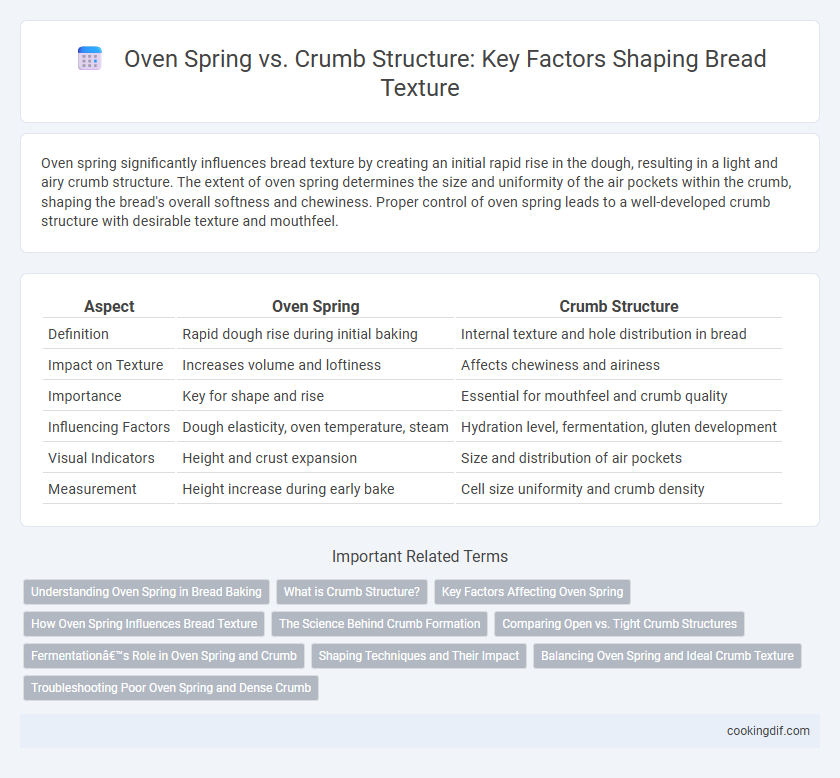Oven spring significantly influences bread texture by creating an initial rapid rise in the dough, resulting in a light and airy crumb structure. The extent of oven spring determines the size and uniformity of the air pockets within the crumb, shaping the bread's overall softness and chewiness. Proper control of oven spring leads to a well-developed crumb structure with desirable texture and mouthfeel.
Table of Comparison
| Aspect | Oven Spring | Crumb Structure |
|---|---|---|
| Definition | Rapid dough rise during initial baking | Internal texture and hole distribution in bread |
| Impact on Texture | Increases volume and loftiness | Affects chewiness and airiness |
| Importance | Key for shape and rise | Essential for mouthfeel and crumb quality |
| Influencing Factors | Dough elasticity, oven temperature, steam | Hydration level, fermentation, gluten development |
| Visual Indicators | Height and crust expansion | Size and distribution of air pockets |
| Measurement | Height increase during early bake | Cell size uniformity and crumb density |
Understanding Oven Spring in Bread Baking
Oven spring refers to the rapid rise of bread dough during the first few minutes of baking, caused by the expansion of gases and the activation of yeast. This phenomenon significantly influences the final crumb structure by creating larger air pockets and a lighter texture inside the loaf. Proper oven spring is crucial for achieving a well-aerated crumb and an appealing crust in artisanal bread.
What is Crumb Structure?
Crumb structure in bread refers to the internal texture and arrangement of air pockets formed during baking, directly impacting softness and chewiness. It results from gas expansion and gluten network development, influencing moisture retention and overall mouthfeel. Understanding crumb structure helps bakers optimize fermentation and baking techniques to achieve desired texture and taste in bread.
Key Factors Affecting Oven Spring
Key factors affecting oven spring in bread include the yeast activity, dough hydration, and temperature during baking. Proper yeast fermentation produces sufficient carbon dioxide, causing the dough to expand rapidly when exposed to oven heat. High hydration levels create a more extensible dough, allowing for better gas retention, while oven temperature influences the rapid gas expansion and starch gelatinization that contribute to optimal oven spring.
How Oven Spring Influences Bread Texture
Oven spring significantly impacts bread texture by rapidly expanding gas bubbles during the initial baking phase, leading to a lighter, airier crumb structure. This rapid rise sets the dough's internal network, enhancing both volume and softness while creating irregular, open crumb patterns favored in artisan breads. Proper oven spring control ensures optimal crust formation and crumb elasticity, directly influencing the bread's tactile appeal and chewiness.
The Science Behind Crumb Formation
Oven spring significantly influences bread texture by rapidly expanding gas cells during initial baking, creating a lighter, airier crumb structure. The science behind crumb formation involves starch gelatinization and gluten protein denaturation, which stabilize gas bubbles and form a network that defines crumb porosity and softness. Controlled oven spring leads to an optimal crumb characterized by uniform holes and tender crumb, crucial for desirable bread mouthfeel and freshness.
Comparing Open vs. Tight Crumb Structures
Oven spring significantly influences the crumb structure of bread, where an open crumb features large, irregular air pockets formed by rapid gas expansion during baking. Tight crumb structures result from slower fermentation and denser dough, producing small, uniform holes with a chewier texture. Bakers often adjust hydration levels and kneading techniques to control oven spring and achieve the desired crumb openness and overall bread texture.
Fermentation’s Role in Oven Spring and Crumb
Fermentation plays a crucial role in bread's oven spring by producing carbon dioxide that expands the dough, resulting in a significant rise during baking. This gas retention also influences the crumb structure, creating a light and airy texture with well-developed alveoli. Proper fermentation balances enzymatic activity and gluten development, optimizing both oven spring and crumb quality for superior bread texture.
Shaping Techniques and Their Impact
Shaping techniques directly influence oven spring by controlling dough tension, which affects gas retention and expansion during baking. Tight shaping creates a strong gluten network, enhancing oven spring and resulting in a lighter, airier crumb structure. Conversely, loose shaping leads to weaker gluten formation, producing a denser crumb with reduced oven spring.
Balancing Oven Spring and Ideal Crumb Texture
Balancing oven spring and crumb structure is crucial for achieving the perfect bread texture, as oven spring directly influences loaf volume and crust development, while crumb structure determines softness and airiness. A strong oven spring requires proper dough hydration, adequate gluten development, and optimal yeast activity, which all contribute to an open, airy crumb with uniform holes. Managing fermentation time and baking temperature ensures the crust sets correctly, preventing excessive collapse and maintaining a desirable balance between a fluffy crumb and a well-risen loaf.
Troubleshooting Poor Oven Spring and Dense Crumb
Poor oven spring in bread results in a dense crumb structure due to insufficient gas expansion during baking, often caused by under-proofing or weak gluten development. Troubleshooting involves ensuring proper dough fermentation times and strengthening gluten through adequate kneading or adding vital wheat gluten. Adjusting oven temperature to optimal levels around 230-260degC (450-500degF) also promotes rapid steam formation, enhancing oven spring and improving crumb lightness.
Oven Spring vs Crumb Structure for bread texture Infographic

 cookingdif.com
cookingdif.com